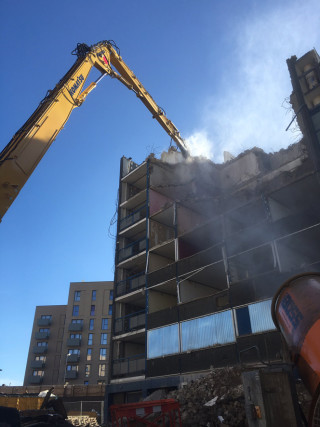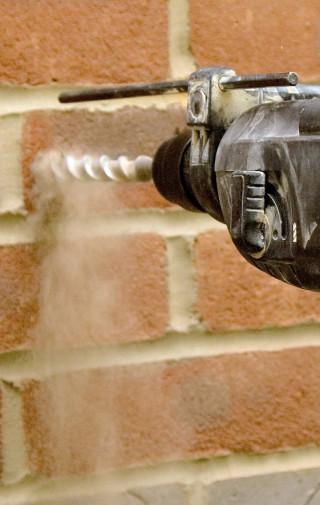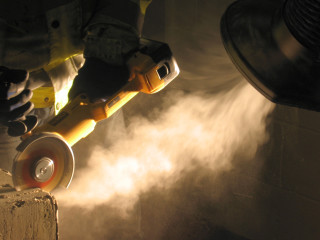Look for silica and you’ll find it almost everywhere. It’s in rocks, sand, clays and gravel. Not surprisingly, it is a major component of many construction materials, including bricks, tiles, concrete and mortar.
But the substance is increasingly being seen as the new asbestos, due to the threat it poses to workers in many sectors, including mining, ceramics, foundry work, quarrying and construction.
Silica poses no risk as part of a finished product. But everyday activities, such as cutting, grinding, polishing or drilling, can generate a very fine dust – respirable crystalline silica (RCS). RCS is not usually visible to the naked eye, but the fine particles can penetrate the lungs. Long-term exposure can give rise to a range of fatal or debilitating diseases, including lung cancer, chronic obstructive pulmonary disease and asthma. There is also an increased risk of kidney disease.
Although silica dust has been linked to deaths in mining and stonemasonry since the 1930s, the construction sector has been slower to catch on. This, says Bud Hudspith, national safety advisor of the Unite union, is partly due to poor diagnosis and the slow development of the illness, which can
often happen decades after initial exposure.
“It could be 20 or 30 years before an X-ray will reveal signs of silicosis. If you look for cases of diagnoses, you don’t find as many as you ought to. People go to their GP with lung problems, and if they smoke, that’s often the end of the investigation,” he says.
“You see guys cutting paving stones, generating huge amounts of silica dust. You worry about what they will be like in 20 years’ time,” he adds.
But silica could finally be having a moment: the all-party parliamentary group (APPG) on Respiratory Health has recently launched an inquiry on the extent and impact of silicosis on construction workers in partnership with B&CE, the not-for-profit financial services organisation.
Samantha Wilding, B&CE’s health policy and public affairs lead, points out that “of the approximately half a million people exposed to silica dust at work in the UK, 81% are employed in construction”.
B&CE brought the issue to the APPG’s attention after discovering that little parliamentary scrutiny had been given to silicosis compared to conditions such as asbestosis.
“The issue of silicosis has not been discussed formally in Parliament for at least five years, during which time the lives of construction workers have continued to be blighted by this devastating disease. It is absolutely the right time for the APPG to take up this important issue,” she says.
But the challenge for employers is that it is not just the people carrying out the work that need to be protected but everyone around them. “Everyone in the area is at risk,” Hudspith says. “As we’re not going to get rid of silica, or bricks or blocks, we need to control the dust, removing it as close as possible to where you’re cutting it.”
For this reason, the HSE and Unite see masks as a last resort option and ineffective on their own. Masks are hot and uncomfortable to wear, and can hinder communication between workers. Equipment that tightly controls or removes the dust is preferred, such as cutting tools that have water sprays to dampen emissions, or machines that extract the dust close to the cutting point.
Hudspith would like to see the risks of silica more explicitly acknowledged in client tenders. There’s usually a clause saying “all health and safety requirements will be met,” he says. The recommendation is that clients should make tenders more specific to explain that any work generating silica dust can only be carried out with controls applied.

If the softly-softly approach does not work, the launch of Unite’s new silica register is likely to focus corporate minds. It has been set up so that workers can keep a record of jobs and sites in which they are being exposed to silica dust, and will operate in a similar way to the union’s existing asbestos register.
As Hudspith says, the intention is not for workers to make claims immediately, due to the long gestation of the illness. But the data could prove invaluable should a worker fall ill in later life.
“In 20 years’ time, people might struggle to remember where they were working. But if they are on the register, some evidence could be used by solicitors,” he argues.
And he believes that the register could also yield useful data trends on where the major risks are occurring, and whether problems keep cropping up at the same location or company: “Our job is to raise awareness. One of the reasons for the register is to get our members asking questions.”

To put the potential of the silica register into context, thousands of workers have signed up to the asbestos register, but a much higher proportion of the sector’s demographic will have been exposed to silica at some point in their careers. This could have significant implications for legal action in the future.
Hudspith predicts that the number of diagnoses for asbestos-related diseases is likely to peak in the early 2020s. After that, silica is likely to take the top spot, becoming the biggest occupational health risk for construction workers.
While there has been much greater recognition of the problem over the past decade and many employers have become more proactive in controlling risk, they should have been doing this 20 years ago, says Hudspith. Now he wants to focus on prevention strategies, tackling the problem at source, rather than resorting to legal action after workers become chronically ill.
“In an ideal world we wouldn’t be needing to seek out compensation. But that’s a little way off yet,” he says.
Silica - what is it?
Silicon dioxide – better known simply as silica – is a natural substance and one of the most abundant on Earth, occurring in most rocks, sands and clays. But the concentration can vary widely: sandstone contains more than 70% silica, whereas granite might contain 15-30%. Silica is also a major constituent of construction materials such as bricks, tiles, concrete and mortar.
The fine dust that can arise from common construction tasks, such as cutting, drilling, grinding or polishing, is known as respirable crystalline silica (RCS) and is too fine to see under normal light conditions.
Exposure to silica
The HSE estimates that 600,000 workers in the UK are exposed to silica dust across all sectors every year (principally, in construction, stoneworking, quarrying, foundries and ceramics).
The Institution of Occupational Safety and Health (IOSH) calculates that 81% of these workers are based in construction.
Safe limits of exposure
In 2006, the Health & Safety Commission (HSC) set a new workplace exposure limit for RCS of 0.1 mg per cubic metre, but in practice employers are expected to keep exposures well below that limit. By contrast, in the USA, the safe limit is half that of the UK and Europe at 0.05 mg per cubic metre.
Lung health and the workplace
According to the UK government’s Labour Force Survey, there are 12,000 lung disease deaths annually that are related to past exposures to substances in the workplace.
Every year there are 20,000 new self-reported new cases of breathing or lung problems that have been made worse by work.
Got a story? Email news@theconstructionindex.co.uk




